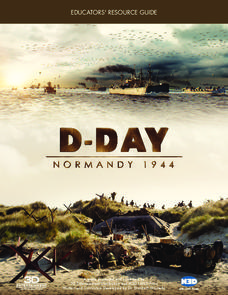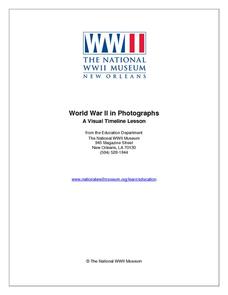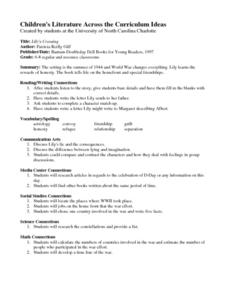D-Day Normandy 1944
D-Day Normandy 1944
No study of World War II would be complete without an in-depth examination of the events of June 6, 1944. Pascal Vuong's D-Day Normandy:1944, is the perfect vehicle to convey the sheer magnitude of the events that have been called the...
Curated OER
Children and World War II
Intended for a younger audience, this presentation provides a very simplistic overview of the people and events key to World War II. They will be introduces to Hitler, Chamberlain, and Churchill, hear an audio piece, and see images from...
Curated OER
World War II Quiz 1
In this World War II learning exercise, students answer short answer questions about the history and geography of World War II. Students complete 13 questions.
National WWII Museum
World War II in Photographs
A picture is worth a thousand words, and this activity is worth so much more! Learners closely analyze a series of photographs from World War II, matching them with their appropriate captions and sequencing them into a correct timeline.
PBS
Pearl Harbor and the Internment of Japanese Americans during World War II
Balancing national security and civil liberties can be tricky. To appreciate the tension between these two concepts, class members investigate the Japanese attack on the U.S. Naval Base at Pearl Harbor and President Franklin D....
Curated OER
World War II: Concentration Camps and Refugees
Students explore the experiences of the people in the concentration camps at liberation during World War II. Students read an article on the Liberation of Belsen Concentration Camp and D-Day and report to the class.
Curated OER
The Daytime D-Day Hour: Producing a D-Day Talkshow
Students analyze the key players and events of D-Day during World War II. They conduct research on an assigned character's role in D-Day, complete worksheets, and plan and participate in a D-Day talk show, presenting information in a...
Curated OER
World War II
Students research World War II and discuss how conflicts in the war lead to change. In this World War II lesson plan, students read books, watch movies, complete activity sheets, and answer questions all researching the war.
National WWII Museum
The Red Ball Express: Statistics as Historical Evidence
Historians use all kinds of information to make conclusions ... including statistics. Young scholars examine how two historians evaluate The Red Ball Express—a supply line staffed primarily by African Americans—using numbers. The...
Alabama Department of Archives and History
Extra! Extra! Read All About It?
Remember the Lusitania! As part of their study of the causes of World War I, class members examine newspaper articles and propaganda posters about the sinking of the Lusitania and then craft their own news story about the event.
Curated OER
The End of the War: WWII
Enhance your student's reading with this presentation on the end of WWII. This series of slides contains information, focus questions to guide student reading, and a video entitled, The Impact of World War II. Note: To view the video...
Curated OER
D-Day Student Worksheet
In this World War II worksheet, students read a 1-page selection about D-Day, examine the listed Internet sources on the topic, and then respond to 8 short answer questions about the information presented.
Curated OER
Memorial Day
As a way to understand Memorial Day, build citizenship, practice vocabulary, and discuss current international conflicts, learners create their own Memorial Day. They design their own memorial after learning about the various types of...
Curated OER
Lily's Crossing
Students listen to a story, "Lily's Crossing," about life during a World War. After completing worksheets, they compare and contrast characters in the story. Using math skills, students develop a time line of the war, calculate the...
Curated OER
Primary History: Children of World War 2 Extension Activity- The War Ends
For this children of World War 2 worksheet, students complete one or more of the three extension activities. Students use timelines to chart the D-Day invasion, tell why many people were thinner but healthier during the war, and discuss...
Smithsonian Institution
Mobilizing Children
Scholars find out how the government used propaganda to mobilize children to help in the war effort. Lesson exercises include analyzing a quote from Franklin Roosevelt, viewing propaganda images and posters, and participating in a lively...
Curated OER
Noncombatancy and the Seventh day Adventist Church
Upper graders investigate how the Seventh Day Adventists are objectors to the practice of war. The lesson covers the Civil War and examines the church's position about the practice of war. The research extends to modern wars and learners...
Curated OER
Events of World War II
Ninth graders examine the main leaders and events of World War II. In small groups they analyze images of main events in WWII, listen to a lecture, and complete a fill-in-the-blank worksheet.
Curated OER
The American Home Front During WWII
Students analyze World War Two era government propaganda, biographies, and historical data in order to better understand the effects on Americans at home. In this American Home Front During World War Two lesson, students compare...
Curated OER
Teaching With Documents Lesson Plan: "A Date Which Will Live in Infamy"
Your class examines F.D.R.'s speech for examples of repetition, alliteration, emotionally charged words, etc. They listen to the speech and interview a person who heard it delivered. They finish by writing an article about the experience.
PBS
The Roosevelts: An Intimate History—Snapshot Lessons
The Roosevelt family was one of the most influential and prominent political forces in the 20th century, leaving behind a wide-ranging legacy of conservation, progressivism, and economic growth. Learn more about President Theodore...
Curated OER
Hitler¿¿¿s Fatal Gamble ? Comparing Totalitarianism and Democracy
Students compare/contrast totalitarianism and democracy and examine their roles in World War II. They read a handout, complete a Venn diagram, and participate in a class discussion.
Curated OER
Fighting for Democracy, Fighting for Me
Students explore the contributions of African Americans, Japanese Americans, and Mexican Americans in World War II. In this World War II lesson, students research Internet and print sources regarding the treatment of the ethnic groups...
Curated OER
Battle of Britain
In this World War II instructional activity, students read an article about the Battle of Britain and then respond to 8 short answer questions.

























